
 |
www.lituanus.org |
|
Copyright
© 1956 Lithuanian
Students Association, Inc.
December,
1956 No.4(9)
|
|
ADOMAS GALDIKAS — NATURE'S PAINTER
PAULIUS JURKUS
PAULIUS
JURKUS, a graduate of University of Vilnius, is editor of Lithuanian
newspaper "Darbininkas". He writes short stories, poetry and articles
on art and literature.
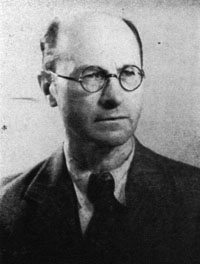 |
In the history of Lithuanian modern painting Pi of. Adomas Galdikas holds one of the leading positions. He possesses a very strong and independent artistic personality which can not be attributed to any famous school, or to any trend. Even though in separate details of his luminous paintings we can find traces of Impressionism as well as of Expressionism, Galdikas is completely individual in his harmonious mode of painting. He is nobody but Galdikas!
Before the First World War Galdikas studied in Petersburg with Prof. Stiglitz. Right after the War he continued his studies in Berlin. As a result of having studied both in the East and West, the artist incorporated western forms of art into the Petersburgian tradition, which basically stressed a realistic delineation of objects. As the beginning of his artistic career, Galdikas' works shaped themselves in the tradition of plastic symbolism. Later the painter found himself on the roads to cubism. But the streams of plastic symbolism and cubism were too narrow for him. He adopted that which was best, which corresponded to this unrestful, always searching nature. He created his own view of the world.
During the years 1930—1933 new movements became apparent in Lithuanian art. The younger generation, having torn itself away from realism, gathered around Ars and Forma societies, where on the one side they went along with modern accomplishments in art, while on other, the young people absorbed the traditional Lithuanian folk art and tried to pass its creative essence on in a new light. A period of renaissance of folk art appeared, while modernism was being combined with purely national elements. The artists were fascinated by the primitiveness and symbolism of the folk art and by its mystic spirit. They were trying to recreate it, even to imitate it.
Galdikas was led by those new artists' movements into long and detailed studies of the environment in which the folk art had matured. He visited ancient and forgotten sites; he was moved by the sad, weather-beaten wayside shrines and crosses. In this manner he discovered a new type of landscape. At first he viewed the beautiful scenery cautiously, stopping at the first border of reality; but later he grasped its nature more deeply.
That is where Galdikas the artist found himself. All he had adopted from various schools, all he had been able to read from nature's beauty and from Lithuanian folk art, all these things melted together and erupted as his original creative force.
We find him painting lonely, forsaken cottages and homesteads, ancient, far-away cemeteries in the fields, and old wayside crosses. He depicts the seashore with the fisherman's boats, their huts and their nets... All these subjects tell the tale of his country. Some of them are calm and peaceful, as if an epic were passing before the viewer's eyes. The others are dramatically intense, as if the trees and cottages were hiding the struggle of the nation; its entire tragic past and the long period of slavery. Galdikas' colors burn like the blood which through generations upon generations has been shed for the country.
In 1944. when the Bolsheviks were occupying Lithuania for the second time, and bringing total slavery with them, Galdikas fled from his counttry. He left his sketches and completed paintings; he left everything, as most people did. All he took with him were the longing, the unrest, and the desire to create valuable works of art.
While living in Germany and in Paris, the painter, in his memories, returns to visit his beloved country. Again he paints the forsaken gray birches and farmers' homesteads. But is it possible for those memory creations to be calm and quiet? Mystic longing and restlessness, which are seen in the trees and lakes and even the clouds, flood this phase of the artist's life. Now Galdikas addresses nature even more delicately; he listens and catches Nature's quivering spirit and rhythm. He reaches a new phase, wherein he experiences nature pan-theistically — he becomes a philosopher of nature, through whose works flows the story of man's sad destiny.
The year 1952 brought Galdikas to the United States. He lives in New York City. From there he visits the countryside, spending most of the summers in the State of Maine. Everywhere he observes nature and its seasons. Galdikas finds most meaning in the dramatic break-through of the elements in autumn and spring.
His landscape paintings have become the stage on which the drama of the artist's experiences is enacted. The trees in a park, the mountains, or the the seashore rocks of Maine are filled with a greatly intensified life. The trees bent in storm and the experiences of autumn and spring, expressed in red stains or fragile blossoms, become the symbols from which man can read his own destiny. Nature's motives transform themselves into man's intimate friends, or even brethren. They converse with us in a restless and stirring language.
Galdlkas' inner restlessness is even more intensified by the colors he uses. He makes more use of colors than any other Lithuanian painter. His works are saturated with azure and orange colors or with burningly sharp tones. Wherever one color seems to be dominating, in the detail we see all possible colors with all their sub-tones. The colors rush in turmoil Joining into a restless rhythm. The colors force themselves out in the forms of mighty fountains; they break into tiny droplets glittering in all the hues of the rainbow. However, even in that endless frolic of colors distinctiveness of form and its subtle balance are not lost.
Color is the constructive and basic element in Galdikas' works. That element dominates his paintings more and more. Objects grow only to become transformed into colorful and rhythmic tones. In such a manner it is even Dossible to find signs of abstractness where usually rhythm and mood rule.
Seized by a great intensity, Galdikas paints very swiftly. All that he wants to express he creates during one sitting. In his experiences, however, he strives patiently through many difficulties towards his aim. Meticulously he studies nature and draws what could be termed as whole diaries of the activities of nature. In every possible surrounding he looks for the subtle, barely noticeable stages of life. He rests only after finding that which later becomes a painting, and then he plunges into a creative state. For that reason tempera paints suit his creative manner best. He does not like oil paints because they do not allow for such a particular play of colors, their combinations, and the unique passages to which tempera yields very conveniently.
Since 1920 Adomas Galdikas has
participated in all
the exhibits staged by Lithuanian artists In Lithuania and abroad. In
1931 he displayed his works in Paris, and, in 1937, in an international
art exhibition he received the Grand Prix and a gold medal. A whole
sequence of exhibits followed in Germany, France, and several other
countries during the period 1946—1948. In the United States
he
had two exhibits in New York and one in Water-bury, Connecticut. His
paintings can be found in the museums of Lithuania and Latvia, in the
Jeu de Paume and Modern Art Museums in Paris, in the Stiglitz gallery
in Petersburg, as well as in the French Cultural Institute and the
Whitney Art Gallery in New York.
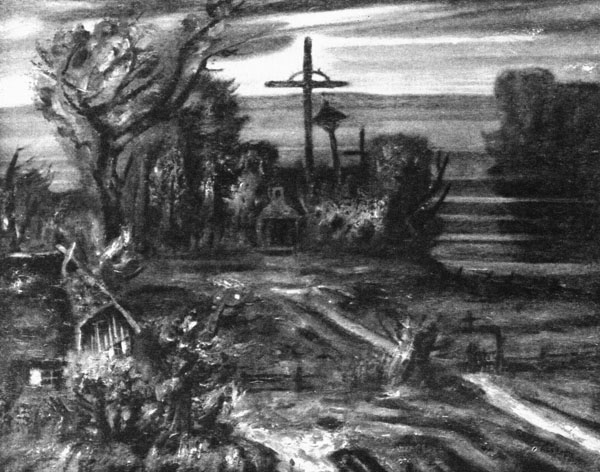
Village Cemetary
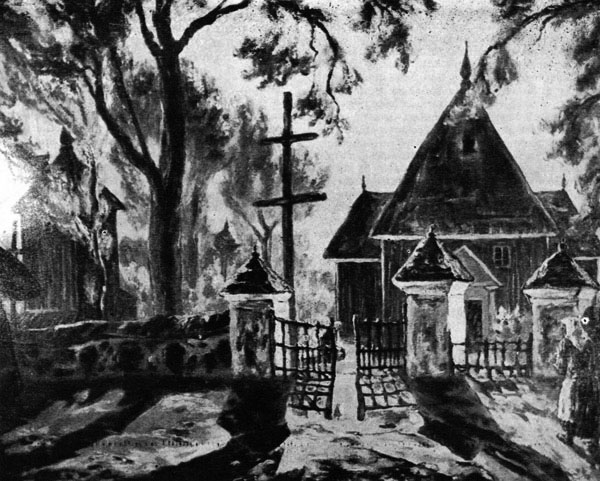
Village Church
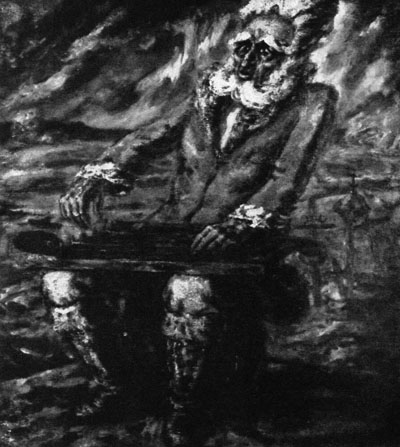
Player of "Kanklės"
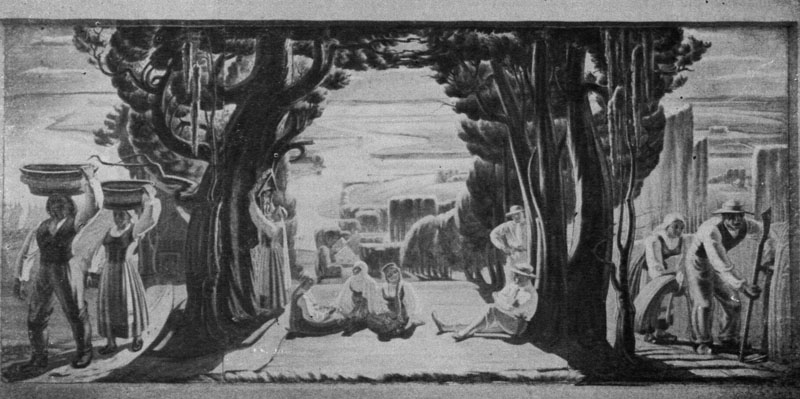
Lithuania
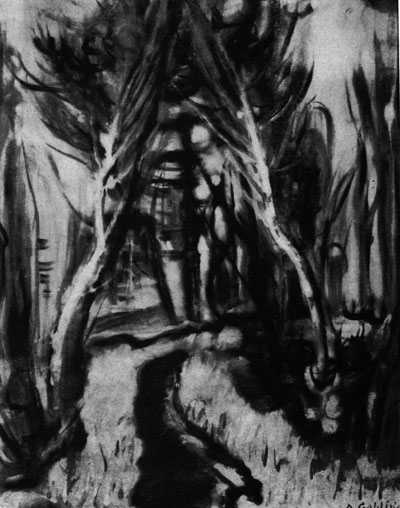
Path in the forest
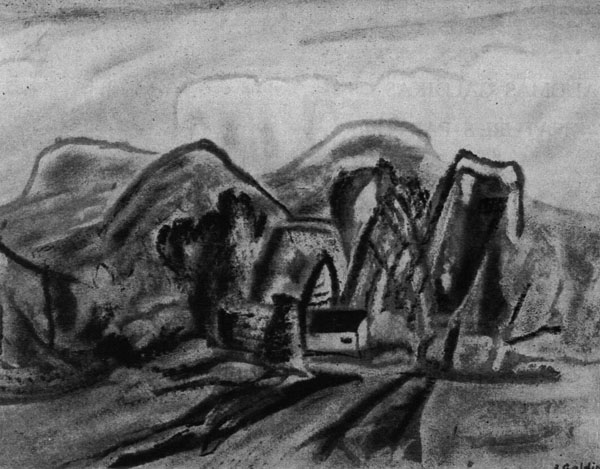
The white mountains
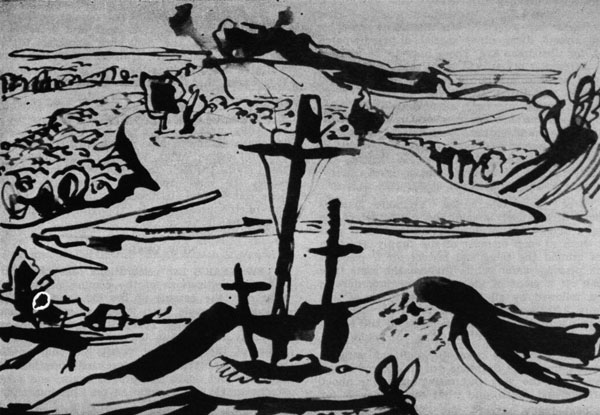
A drawing
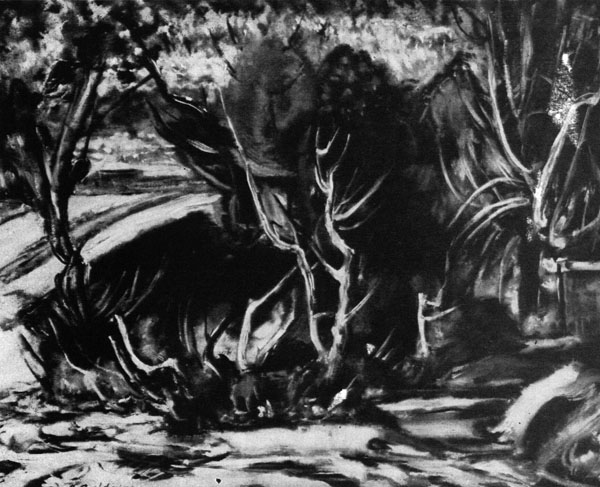
Winter
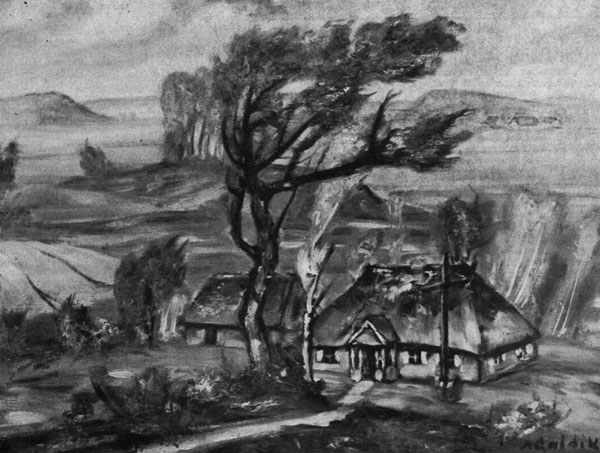
A homestead